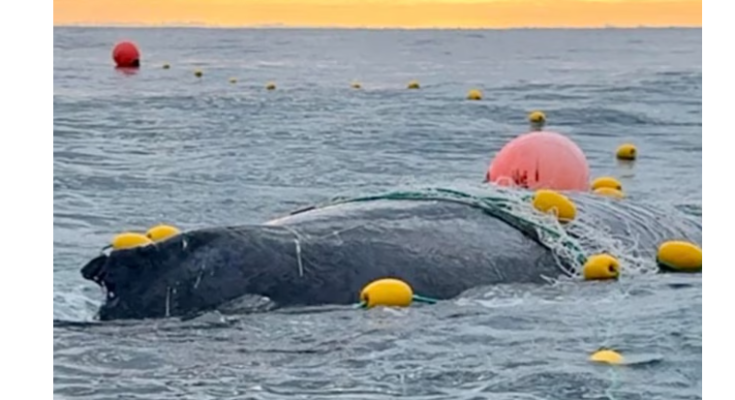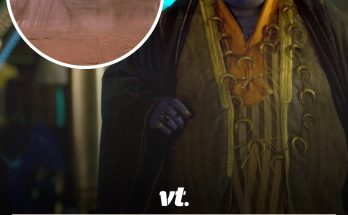In short
Sunshine Coast locals have broken the law to rescue a humpback whale trapped in a shark net.
Members of the group say they knew the risks but could not let the animal suffer and swum out to cut it free.
What’s next
The Department of Agriculture and Fisheries is considering whether an investigation is required into possible offences under the Fisheries Act.
A group of paddle boarders has risked legal action and fines of more than $30,000 to rescue a humpback whale trapped in a shark net off the Sunshine Coast.
Marine authorities say their actions were against the law and risked injury from a distressed and unpredictable whale.
But Will Wensley and Brenton Owens abandoned plans for a sunrise swim and yoga session at Marcoola Beach when they saw the whale in distress on Monday.
Mr Owens said they reported their sighting to authorities but when no-one had arrived almost an hour later they took action, fearing the whale was “drowning”.
Mr Wensley and Mr Owens — along with friends Luke Bird and Jaz Sol — paddle boarded out and cut the net with a knife just after 7am.
Mr Owens said the whale was “wrapped entirely in two layers of net”.
“It was on the surface, but it was not moving,” Mr Owens said.
“Shortly after we got out there, it took a deep breath, and released a lot of air.
“And then it slowly actually sunk under the water and [bubbles appeared], and we all turned to each other and said, ‘Oh my God … is that its last breath?'”
Mr Owens said his priority was to cut away the net that was “rubbing back and forth” over the whale’s eye.
“I just knew I had to at least free its eye, if I could do nothing else at the time,” he said.
“That was my main priority, to comfort the animal and let it relax.”
The whale eventually swam away.
The Department of Agriculture and Fisheries (DAF) said the incident was first reported to the Shark Control Program hotline at 6:20am.
A Marine Animal Release Team was en route to release the whale when it was advised members of the public had already done so.
Beachgoers urged not to put themselves at risk
In recent years there have been several reports of members of the public trying to assist with whale rescue operations.
In 2022, surfers twice attempted the rescue of a whale from a shark net at Currumbin.
And in 2020, a recreational diver escaped a fine after cutting free a humpback in Burleigh Heads.
But James Cook University senior lecturer in marine biology and aquaculture Naomi Gardiner said in each case, the rescuers were putting themselves in great danger.
“Humpback whales are enormous animals, exceptionally heavy, and in distress they will act quite erratically,” she said.
“Particularly in this kind of entanglement situation, they could quite easily just by movement of their body knock a person out, causing death or substantive injury to the well-intended rescuer.”
A humpback’s pectoral fin alone can be 5 metres long and weigh up to a tonne.
Under Queensland legislation, a person can be fined $19,356 for entering waters within 100m of a whale.
The fine does not apply if a person has a “reasonable excuse”.
It is also illegal to come within 20m of shark nets used in the state government’s shark control program.
The maximum penalty is a $32,260 fine, and there is no “reasonable excuse” exemption.
In relation to the Marcoola incident, a DAF spokesperson said the department would “consider whether an investigation is required into possible offences under the Fisheries Act 1994, namely the 20-metre exclusion zone that applies to shark control equipment”.
“For their own safety, we remind the public not to approach or try to release whales trapped in nets,” the spokesperson said.
“Call the Shark Control Program hotline on 1800 806 891 and let the trained and properly equipped experts do their job.”
‘Like an elephant in pain’
Mr Wensley said the group considered their safety and the potential penalties but felt the situation was so urgent, they had to act.
“The sound was like an elephant in pain, just screaming,” he said.
“[DAF] weren’t there … no one came
“They’d already been called in an hour before we were there, and this animal was literally dying, it was drowning.”
It is the second whale entanglement involving shark nets on the Sunshine Coast since the start of this year’s whale migration.
Sea Shepherd Australia shark defence campaigner Jonathan Clark said the shark nets — introduced in the 1960s — were “barbaric” and should be removed.
A DAF spokesperson said the state government has committed $1 million a year to research and trial alternatives to current shark control equipment and a further $2 million a year to a drone trial.
The department said the damaged net at Marcoola would be replaced “when conditions allow”.



